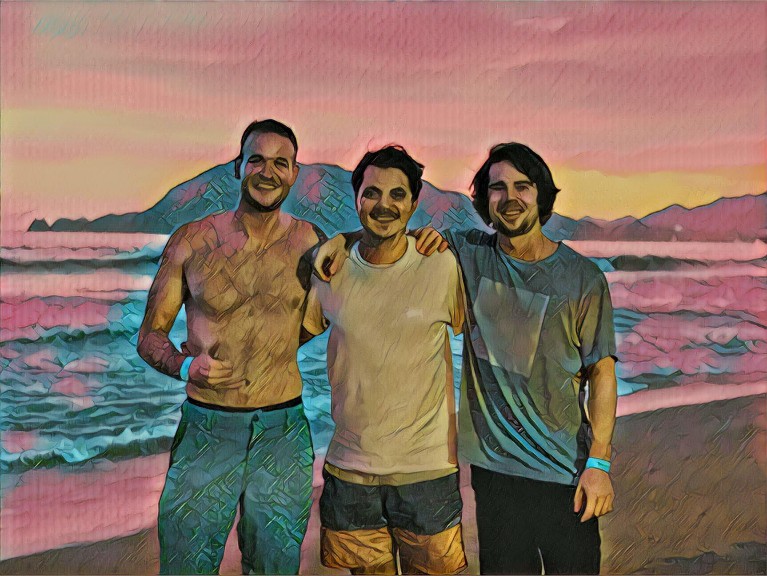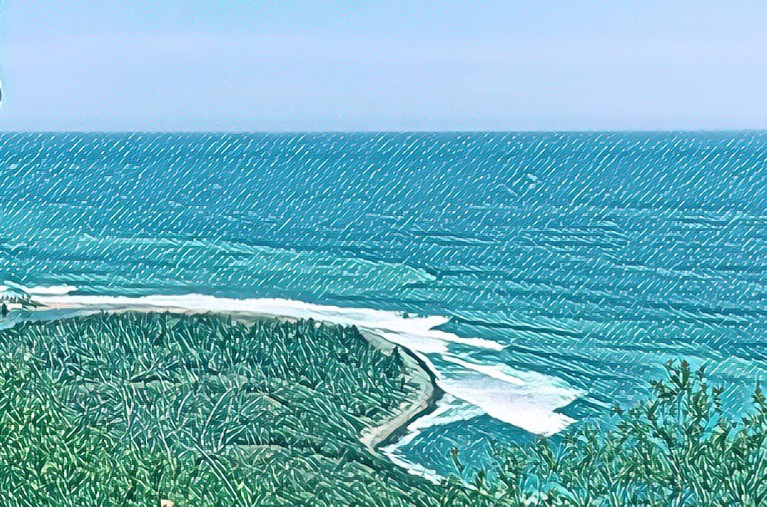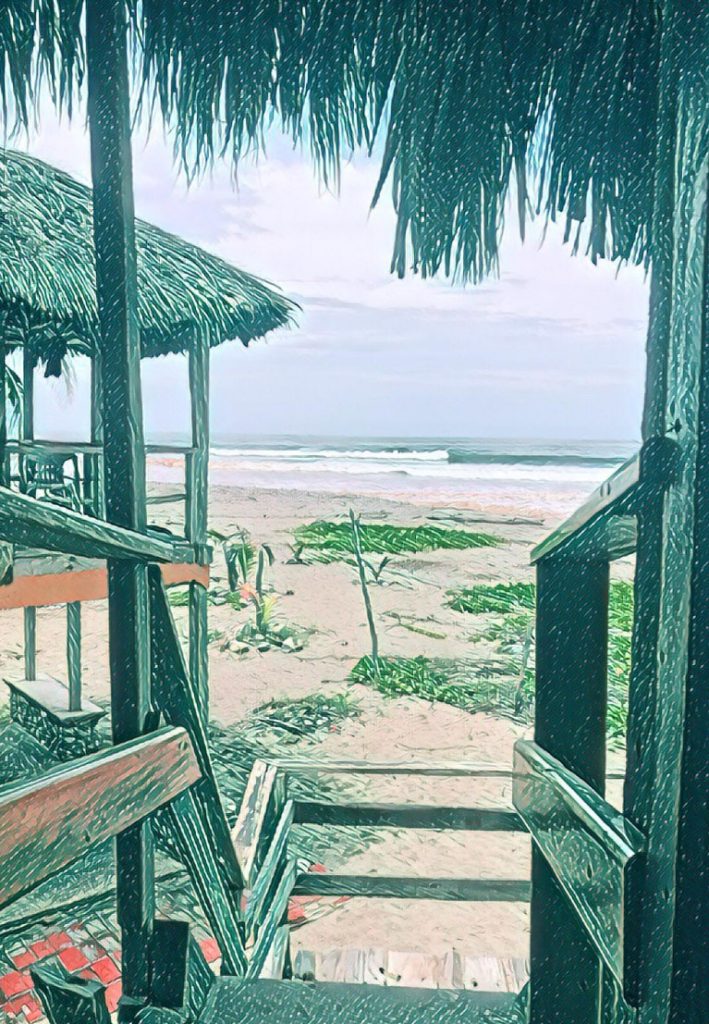The more time I spent in Sayulita, the more my confidence returned and the larger the waves that I surfed. Days slipped into a comfortable rhythm – wake early, surf, eat, nap, surf, party, repeat. Everyone at the hostel was there for the same reason, so we all became tight very quickly.
Kristian, the Norwegian, was a fairly serious surfer, and had brought his own shortboard all the way from the arctic circle for this trip. He was quiet, but once the topic of something he was passionate about came up, he could talk excitedly for hours.
Mark, the Dutchie, had done an exchange in Indonesia, and learned to surf with friends on deserted breaks far from tourism capital Bali. Like me, he didn’t have a board and was renting instead. He was easygoing and had a very distinctive laugh, which reminded me of a goat rolling down a hill.
Sayulita was a great little town, and it had decently consistent, if small, swell. To get to other breaks, we had to catch a bus, or hitchhike. After a couple days, Kristian had a proposal.
What if we rented a car together to surf different breaks?
Once we had the idea, it wouldn’t go away. On Friday Kristian and I caught a bus to Puerto Vallarta, where we got a 9 day rental. Thus began the search1In surf culture, the search is for the perfect wave – a combination of size, shape, ride length, and lack of other surfers clogging it up. It’s also about the culture and the experiences found along the way in that search. In Barbarian Days: A Surfing Life, author William Finnegan spends 2 years searching for the perfect wave, a journey that takes him throughout the pacific and culminates in a deserted island, fishing for food next to the best wave he’d ever seen. It’s also the slogan of Ripcurl, a popular surf apparel company; you can read more about their definition and ensuing adventures here.
We stayed in Sayulita for the weekend, but took the car went to explore Punta Mita, a 30 minute drive to the south. There we found La Loncha, a perfect longboard wave only a 10 minute hike from the side of the road. It wasn’t exactly the search – there was an excellent rental spot across the street, and were never less than 10 people at the peak of the wave – but it was an incredible start.
La Loncha was a gentler wave which required more speed to catch, perfect for longboarding. There was a channel nearby the peak2The peak is where the wave breaks. To get the best rides, you generally want to take off from the peak, offering a reprieve from breaking waves as we paddled out. I rented an 8’4’’ NSP and was ecstatic about its performance. On the first day, the swell was head high3Waves are measured by their size comparison to people, which is silly since each person is a different height. Sizes range from waist high, shoulder high, head high, overhead, and then various levels of overhead+, at which point simple feet or meter measurements are more common. Head high is generally 5-6 feet, while 1.5x overhead is probably a 8-9 foot wave., but I had no problem catching waves and was exhilarated to peel down the smooth faces.
The second day, it was even bigger – overhead+, maybe even 1.5 times overhead. It was also harder to determine which was a good wave. There were maybe 10 surfers near the break, and whenever a standout set4A set is a set of waves – they generally come in groups of 3-5. Standout sets are especially big ones. reared its head in the distance, we sprint-paddled towards it to avoid having massive waves breaking on us. There was a solid offshore wind5Wind direction is critical for surfers. A solid offshore breeze – where the wind blows from the coast out to the ocean – will hold a wave up in perfect position; an onshore breeze – the opposite – will often blow the waves out and make them impossible to catch., so when we went over a crest, a small shower would hit us from behind.
Midway through our session, it began to rain. I sat on my board in that gentle rain, amplified by the water blown off the waves crashing ahead of me, and felt more content than I had in a long time. I was as much a part of nature out in that ocean as I could be. I was happy that after an 8 month break from surfing, I could essentially pick back up right where I left off. And then I saw a perfect wave, started paddling, dropped into it, screeching across the face and caught it halfway back to the shore. I couldn’t wipe the smile off my face the rest of the day.
The next day we left for Manzanillo, a 5 hour roadtrip. We drove through the grandiose resorts of Puerto Vallarta, past the seaside cliffs of Boca de Tomatlán, and through the purest jungle we had yet seen. It turns out Kristian was a big hip hop fan, so we bumped Norwegian rappers I’d never heard of and dirty south classics such as International Players Anthem and Still Tippin’ in equal measure. The jungle gave way to chapparal plains, and as we rounded a corner, we came to a complete stop.
People were walking up and down the road, and but no cars were moving. Mark and I discovered there was an 18-wheeler overturned on a bridge ahead, blocking both lanes of traffic. Apparently 2 people had died in the accident. “How long do you think it’ll take to clear the road?” I asked. “4 or 5 hours” a man in a wifebeater said happily, as his companions nodded vigorously6They seemed to take pride in the difficulty in the situation and their ability to deal with it. It struck me as a very specific expression of the famed mexican machismo..
We eventually found a detour7Not immediately however – first we stopped by a building that happened to the site of Paradise Hotel, a famous Norwegian reality show. By complete luck, it was visible from the highway, near where the accident occurred. When we got to the gate, a bemused security guard asked what we were doing there. Apparently they didn’t allow guests. A missed opportunity to pretend like we were part of the Norwegian press and sneak our way onto the show. and 3 hours later made it to Manzanillo. Our hostel had a bar directly on the beach, and we had a great view of the ocean from the third floor balcony where our dorm was located. Unfortunately, the waves were closeouts8Closeouts aren’t really rideable, because they break at the same time everywhere – the only thing you can ride is whitewater. Not worth it unless you’re just starting out. and the hostel was empty.

The next day, closeouts continued at Manzanillo, so we drove another hour to check out a surf spot called Paraíso, as well as Boca de Pascuales, which was known to have massive waves (double overhead+) on a sandbar break. Paraíso was a bust, but we had a very entertaining lunch watching the monstrous waves of Pascuales the efforts of a single surfer to ride them.
When we arrived back to Manzanillo, we had to cement our plans. We’d started the roadtrip with the vague idea to make it down to Troncones, a surf break near Zihuatanejo, nearly 10 hours south of Puerto Vallarta where we’d started. As we looked at the map, there were second thoughts. Kristian, who had to return the car, didn’t want to drive all the way down to Troncones only to drive so far back alone. Mark saw the forecasts for the upcoming breaks, thought they were too advanced for him, and started to reconsider his entire itinerary. I was determined to make it to Zihuatanejo.
All of the sudden, all of our plans changed: Mark decided to go to Guadalajara to experience more Mexican culture, while Kristian and I decided to continue on to the next surf break, 2.5 hours away. We wouldn’t make it to Troncones and Zihuatanejo together, but if the next break was as good as we hoped9In surf culture, it’s usually bad manners to give away information on particularly good, hidden breaks, as they will quickly become more crowded. For that reason, I’ll call the next break simply, “Olas Altas”., we’d spend the rest of our time there.
We woke up the next day at 6am, aiming to get to the break by 9. We couldn’t find any places to stay online, but hoped things would work out. It was still dark when we left, but the sun slowly rose over the horizon as we passed endless speed bumps and a winding road through steamy jungle. We were high above the ocean when Kristian got the first sight of the wave. “Shit!” he said. “Good?” “Really good”.

We drove into a small town seemingly abandoned in the morning light. As we wobbled through the cobblestone roads, dogs barked and chased the car, and chickens clucked their way out of the road. For both of us, it was the smallest town we’d yet been to. Arriving to the coast, we saw something incredible. Directly in front of us, 10 feet high, was a hollow, powerful right wave. A short walk north and the coast sloped backward, creating an even better left.
“I’m willing to camp for this” Kristian exhaled breathlessly, and I nodded my agreement. This was easily the best wave I’d ever seen in person, and unlike the crowded breaks of Los Angeles or San Diego, it was almost empty – there were six people in the ocean.
Just as Kristian was ready to go out, a storm blew a strong onshore wind onto the break, silencing the wave. We found the accommodation at beachside cabanas immediately next to the break, and waited for the waves to improve. Wifi was limited, which only added to the vibe. The cabana complex and its campgrounds were the only housing in town, and for hours in any direction for that matter. It felt as if we were lodging at the very end of the world.
Towards the end of the day, the waves picked up, and I decided to paddle out. This town was so small, there weren’t surfboard rentals, but Kristian offered to let me borrow his 6’ foot shortboard. It was a ridiculous escalation in surfing – eight days ago, I wasn’t sure that I could surf at all, and stuck to waist high or smaller waves. 4 days ago I was on overhead longboard waves, and now I was about to paddle out into 10 footers, 1.5x overhead, the biggest I’d ever surfed, and for the first time on a shortboard to boot. And yet there was something in the magic of this place, with its isolation and endless horizon, that made me believe it was all possible.
When I paddled out, I realized… I was wrong.
Powerful waves pummeled me more than usual – since I couldn’t really duck dive correctly, I was taking them head on. I was in decent surf shape, but was not prepared for the ferocity of the swell. I reached the break, or what I thought was the break, when I saw even larger waves breaking in the distance. After another set of pummelling, I paddled in. This was challenging since I had to climb out to the ocean on slippery rocks, timing my advances with the pounding tide. I was slammed against the shore a couple times as I struggled for balance, hoping to avoid dinging Kristian’s board.
I was too banged up to surf after that, but contented myself with reading, relaxing, and watching other surfers to learn technique. At night Kristian and I sat in the dim light of the porch outside our cabana playing cards, drinking caguamas10In Spanish this means “Sea Turtle” but is used to describe 1L bottles of beer that are common in Mexico and chatting about our lives.
On Friday, the roadtrip ended. Kristian dropped me at the next break, Rio Nexpa, and began the return trip to Olas Altas, from which he would return to Puerto Vallarta. I was tired, physically and emotionally. Even as an extrovert, I was ready to recharge with some quality alone time after two full weeks of socializing.
Rio Nexpa was smaller than Olas Altas – perhaps only 6 feet, or head high – and less powerful. I rented a private cabana on the beach, where I could see the break directly from my second floor balcony. There was even less internet access here than in Olas Altas, so I passed two idyllic days without it – reading, eating, surfing, and soaking in the isolation.

Technically, the week was an unproductive one. Since my goal on the trip is to learn Spanish, anything that doesn’t support this goal is by definition unproductive, and I wasn’t improving my Spanish spending all day with Kristian and Mark. But the allure of waves, of reclaiming my place in the sea, was simply too powerful. I think I needed to surf to feel whole again.
Miscellaneous Notes:
- The photo at the top of this post isn’t me – it’s Kristian catching a sweet wave at Olas Altas. The template doesn’t let me add a caption to the main photo, but I think this is the one that best captures the spirit of our surf adventure.
- Also on our roadtrip, there was a moment where the 2 lane highway was blocked by a herd of cows lumbering up the street. We slowed down to their plodding pace, and hoped they would clear out, but it was to no avail. I was concerned they would damage the car, but they were quite content to rumble along, peeing and pooping where they pleased. Then a red motorcycle pulled up behind us, gave a few honks, and they immediately cleared out.
- I might have mentioned this in another post, but Mexican roads have more speedbumps than just about anywhere in the world. They are ostensibly for safety, but I wonder what the impact is on gas mileage. We had to break hard anytime we saw one, and there were at minimum 3-4 strategically placed by every village we passed.
- At Olas Altas I lazed around in a hammock and finished Harry Potter y la Piedra Filosofal, the second full book I’ve read in Spanish. It’s definitely a bit more advanced than The Alchemist, and is another good indication of progress. In Rio Nexpa, the town convenience store had free books, and I picked up a battered copy of Caravans by James A. Michener. It’s a historical fiction novel about post WWII Afghanistan. It was nice to read something in English, and I sped through it at 100ish pages per day.
